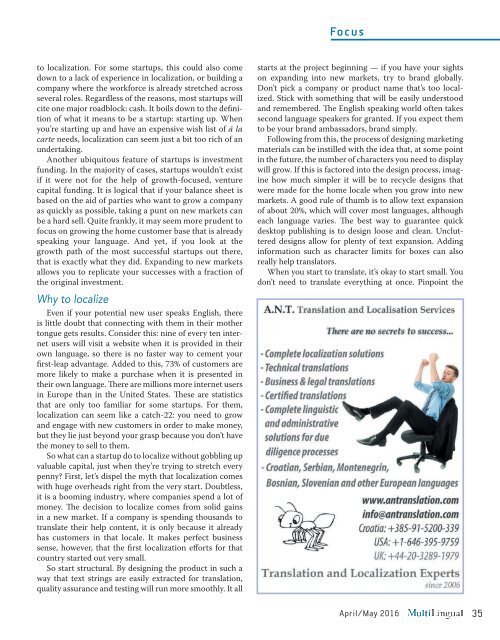Localization
z99kl79
z99kl79
You also want an ePaper? Increase the reach of your titles
YUMPU automatically turns print PDFs into web optimized ePapers that Google loves.
Focus<br />
to localization. For some startups, this could also come<br />
down to a lack of experience in localization, or building a<br />
company where the workforce is already stretched across<br />
several roles. Regardless of the reasons, most startups will<br />
cite one major roadblock: cash. It boils down to the definition<br />
of what it means to be a startup: starting up. When<br />
you’re starting up and have an expensive wish list of á la<br />
carte needs, localization can seem just a bit too rich of an<br />
undertaking.<br />
Another ubiquitous feature of startups is investment<br />
funding. In the majority of cases, startups wouldn’t exist<br />
if it were not for the help of growth-focused, venture<br />
capital funding. It is logical that if your balance sheet is<br />
based on the aid of parties who want to grow a company<br />
as quickly as possible, taking a punt on new markets can<br />
be a hard sell. Quite frankly, it may seem more prudent to<br />
focus on growing the home customer base that is already<br />
speaking your language. And yet, if you look at the<br />
growth path of the most successful startups out there,<br />
that is exactly what they did. Expanding to new markets<br />
allows you to replicate your successes with a fraction of<br />
the original investment.<br />
Why to localize<br />
Even if your potential new user speaks English, there<br />
is little doubt that connecting with them in their mother<br />
tongue gets results. Consider this: nine of every ten internet<br />
users will visit a website when it is provided in their<br />
own language, so there is no faster way to cement your<br />
first-leap advantage. Added to this, 73% of customers are<br />
more likely to make a purchase when it is presented in<br />
their own language. There are millions more internet users<br />
in Europe than in the United States. These are statistics<br />
that are only too familiar for some startups. For them,<br />
localization can seem like a catch-22: you need to grow<br />
and engage with new customers in order to make money,<br />
but they lie just beyond your grasp because you don’t have<br />
the money to sell to them.<br />
So what can a startup do to localize without gobbling up<br />
valuable capital, just when they’re trying to stretch every<br />
penny? First, let’s dispel the myth that localization comes<br />
with huge overheads right from the very start. Doubtless,<br />
it is a booming industry, where companies spend a lot of<br />
money. The decision to localize comes from solid gains<br />
in a new market. If a company is spending thousands to<br />
translate their help content, it is only because it already<br />
has customers in that locale. It makes perfect business<br />
sense, however, that the first localization efforts for that<br />
country started out very small.<br />
So start structural. By designing the product in such a<br />
way that text strings are easily extracted for translation,<br />
quality assurance and testing will run more smoothly. It all<br />
starts at the project beginning — if you have your sights<br />
on expanding into new markets, try to brand globally.<br />
Don’t pick a company or product name that’s too localized.<br />
Stick with something that will be easily understood<br />
and remembered. The English speaking world often takes<br />
second language speakers for granted. If you expect them<br />
to be your brand ambassadors, brand simply.<br />
Following from this, the process of designing marketing<br />
materials can be instilled with the idea that, at some point<br />
in the future, the number of characters you need to display<br />
will grow. If this is factored into the design process, imagine<br />
how much simpler it will be to recycle designs that<br />
were made for the home locale when you grow into new<br />
markets. A good rule of thumb is to allow text expansion<br />
of about 20%, which will cover most languages, although<br />
each language varies. The best way to guarantee quick<br />
desktop publishing is to design loose and clean. Uncluttered<br />
designs allow for plenty of text expansion. Adding<br />
information such as character limits for boxes can also<br />
really help translators.<br />
When you start to translate, it’s okay to start small. You<br />
don’t need to translate everything at once. Pinpoint the<br />
April/May 2016 35


